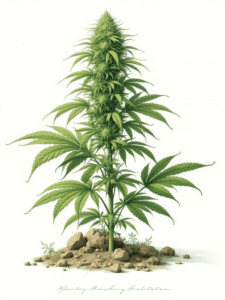Basic Plant Anatomy of Cannabis
The botany of the cannabis plant can be as mysterious and complex as cannabis itself. Unless you’re a botanist, the distinction between parts like stipules and calyxes may feel like too much information. However, to truly appreciate this plant’s natural wonder, every cannabis enthusiast should have a basic understanding of its structure. Let’s break it down:

Flowers (Buds)
The flowers, also known as buds, of the female cannabis plant are what we harvest, trim, dry, cure, and ultimately consume. These buds contain the highest concentrations of cannabinoids, especially THC, which is responsible for the plant’s psychoactive effects. The largest bud at the top of the plant is called the cola, which is prized for its potency.
Trichomes and Pistils
The real magic of cannabis happens in the trichomes. These tiny, crystal-like resin glands found on the surface of the bud are where all the valuable chemical compounds are stored. Trichomes are rich in cannabinoids and terpenes, which give cannabis its unique effects and aroma.
The pistils, often appearing as red or white hairs, grow out of the bud. While they indicate a well-grown plant, they don’t contain significant cannabinoids and are not an indicator of potency.
Trichomes
These resinous glands are responsible for the production of cannabinoids like THC and CBD. They contribute to the plant’s potency and its therapeutic effects.
Pistils
Pistils are essential for the plant’s reproduction but don’t play a significant role in the effects felt by consumers.
Fan Leaves
The fan leaves are the large, recognizable leaves that have become the unofficial symbol of cannabis culture. These leaves are responsible for absorbing light for photosynthesis, allowing the plant to grow. However, they contain little to no THC and are usually discarded after harvest.
Leaf Anatomy
Cannabis leaves have a distinctive structure:
- Leaflets: Cannabis fan leaves typically have seven to nine leaflets, with some plants displaying up to eleven.
- Bracts: These small, protective leaves encase the reproductive organs of the plant.
- Petiole: This is the stalk that connects the leaf to the stem.
Sugar Leaves
Unlike fan leaves, sugar leaves are smaller and grow within the buds. They are coated with trichomes, giving them a sugary appearance. These leaves are typically trimmed off the buds during harvest and are often used to make edibles or concentrates due to their cannabinoid content.
Stems
The stems provide structural support for the cannabis plant and store nutrients while transporting water from the roots. Despite their crucial role, stems contain little to no THC and are generally discarded after harvesting.
Seeds
Cannabis seeds are essential for plant reproduction. Female plants that are not pollinated by males produce seedless buds known as sinsemilla, which are more desirable due to their higher resin and cannabinoid content. Besides being used for cultivation, cannabis seeds are also a nutritious food source and can be processed into oil for use in renewable fuels.
Stalks
Similar to stems, stalks don’t contain THC but are highly valuable for their long fibers, which can be processed into hemp. Hemp is a strong and versatile material used in making paper, rope, textiles, biodegradable plastics, and clothing.




